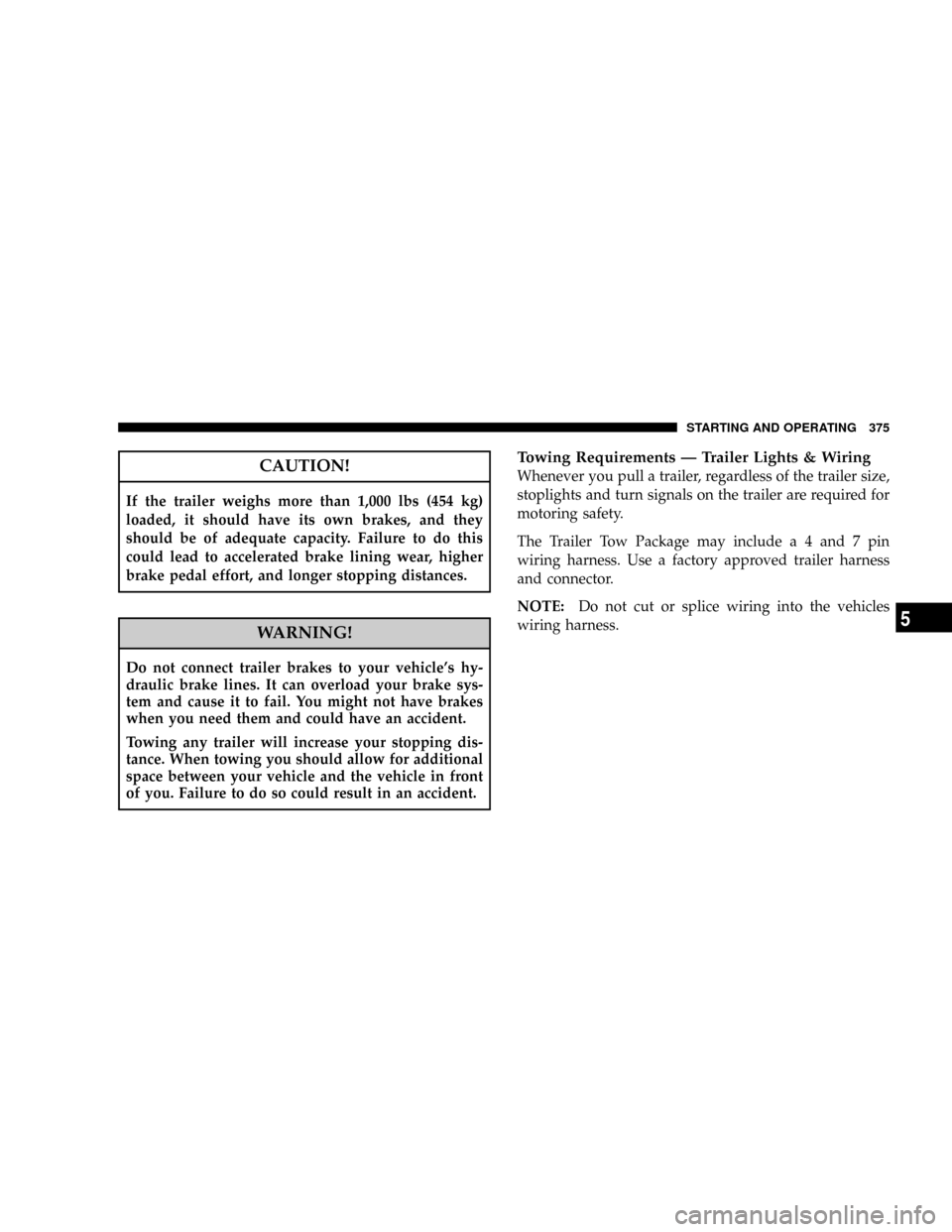Page 298 of 493

original position, make certain all shift requirements
have been met, wait five (5) seconds, and try the shift
again.
²The ignition switch must be in the ON position for a
shift to take place and for the position indicator lights
to be operable. If the ignition switch is not in the ON
position, then the shift will not take place and no
position indicator lights will be on or flashing.
MP3022 Selec-Trac IITTransfer Case Ð If
Equipped
Operating Information & Precautions
The Selec-Trac IItactive on-demand transfer case pro-
vides four positions:
²2 (rear) wheel drive high range.
²4-wheel drive auto high range.
²Neutral.
²4-wheel drive low range.
This transfer case is intended to be driven in either the
2-wheel drive position (2WD) or the 4-wheel drive Auto
position (4WD Auto) for normal street and highway
conditions such as dry hard surfaced roads.
For added capability when traversing steep grades,
rough terrain, or extremely poor traction surfaces, select
the transfer case 4WD Low position. This position locks
the front driveshaft and rear driveshaft together and
forces the front and rear wheels to rotate at the same
speed while multiplying engine torque.
Use the transfer case Neutral (N) position for recreational
towing only. Refer to ªRecreational Towingº in this
section for specific procedures on shifting into and out of
Neutral (N).
298 STARTING AND OPERATING
Page 301 of 493

Interlocking Ignition Systemº under ªManual Transmis-
sionº or to ªStarting Proceduresº in this section for
details.
N
Neutral - Disengages both the front driveshaft and rear
driveshaft from the powertrain. To be used for flat
towing behind another vehicle. Refer to ªRecreational
Towingº in this section for more information.
Transfer Case Position Indicator Lights
The 4WD indicator lights are located in the instrument
cluster. The ªNº (Neutral) indicator light is located on the
4WD Control Switch. If there is no indicator light on or
flashing, the transfer case position is 2-wheel drive
(2WD). If the indicator light is on, the desired position
(4WD AUTO, 4WD LOW, or NEUTRAL) has been ob-
tained.If One or More Shift Requirements are not met:
²An indicator light will flash.
²The transfer casewill notshift.
NOTE:The ªSERV 4WDº warning light monitors the
electric shift 4WD system. If this light remains on after
engine start up, or it illuminates during driving, it means
that the 4WD system is not functioning properly and that
service is required.
Shifting Procedures
NOTE:If any of the requirements to select a new
transfer case position have not been met, the transfer case
will not shift, the indicator light for the previous position
will remain ON, and the newly selected position indica-
tor light will continue to flash until all the requirements
for the selected position have been met. To retry a shift,
move the 4WD Control Switch back to the original
STARTING AND OPERATING 301
5
Page 303 of 493

2. With the ignition switch in the ON position and the
engine OFF or RUNNING, shift the transmission into
ªNº (Neutral) (automatic transmission), or depress the
clutch pedal (manual transmission).
3. Move the 4WD Control Switch to the desired position.
4. After the desired position indicator light is ON (not
flashing), shift the transmission into gear (automatic
transmission), or release the clutch pedal (manual trans-
mission).
NOTE:
²Steps 1 and 2 in the ªPreferred Procedureº and the
ªAlternate Procedureº are requirements for shifting
the transfer case. If these requirements are not met
prior to attempting the shift or while the shift attempt
is in process, then the indicator light will flash, and the
current transfer case position will be maintained. To
retry a shift, move the 4WD Control Switch back to theoriginal position, make certain all shift requirements
have been met, wait five (5) seconds, and try the shift
again.
²The ignition switch must be in the ON position for a
shift to take place and for the position indicator lights
to be operable. If the ignition switch is not in the ON
position, then the shift will not take place, and no
position indicator lights will be on or flashing.
ON-ROAD DRIVING TIPS
Utility vehicles have higher ground clearance and a
narrower track to make them capable of performing in a
wide variety of off-road applications. Specific design
characteristics give them a higher center of gravity than
ordinary cars.
An advantage of the higher ground clearance is a better
view of the road, allowing you to anticipate problems.
They are not designed for cornering at the same speeds as
STARTING AND OPERATING 303
5
Page 375 of 493

CAUTION!
If the trailer weighs more than 1,000 lbs (454 kg)
loaded, it should have its own brakes, and they
should be of adequate capacity. Failure to do this
could lead to accelerated brake lining wear, higher
brake pedal effort, and longer stopping distances.
WARNING!
Do not connect trailer brakes to your vehicle's hy-
draulic brake lines. It can overload your brake sys-
tem and cause it to fail. You might not have brakes
when you need them and could have an accident.
Towing any trailer will increase your stopping dis-
tance. When towing you should allow for additional
space between your vehicle and the vehicle in front
of you. Failure to do so could result in an accident.
Towing Requirements Ð Trailer Lights & Wiring
Whenever you pull a trailer, regardless of the trailer size,
stoplights and turn signals on the trailer are required for
motoring safety.
The Trailer Tow Package may includea4and7pin
wiring harness. Use a factory approved trailer harness
and connector.
NOTE:Do not cut or splice wiring into the vehicles
wiring harness.
STARTING AND OPERATING 375
5
Page 381 of 493

²The ignition switch must be in the ON position for a
shift to take place and for the position indicator lights
to be operable. If the ignition switch is not in the ON
position, the shift will not take place and no position
indicator lights will be on or flashing.
²Flashing Neutral (N) position indicator light indicates
that shift requirements have not been met.
CAUTION!
Damage to the transmission may occur if the trans-
mission is shifted into ªPº (Park) with the transfer
case in Neutral (N) and the engine RUNNING. With
the transfer case in Neutral (N), ensure that the
engine is OFF prior to shifting the transmission into
ªPº (Park).
Shifting Out of Neutral (N)
Perform the following procedure to prepare your vehicle
for normal usage:
1. Bring the vehicle to a complete stop.
2. Reconnect the battery negative cable.
3. Place the ignition switch in the LOCK position (if it
has been moved or the engine has been started).
4. Turn the ignition switch to the ON position, but do not
start the engine.
5. Depress the brake pedal.
6. Shift the transmission into ªNº (Neutral) (automatic
transmission), or depress the clutch pedal (manual trans-
mission).
7. Use the point of a ballpoint pen or similar object to
depress the recessed transfer case Neutral (N) button.
Release the Neutral (N) button after the Neutral (N)
STARTING AND OPERATING 381
5
Page 382 of 493

indicator light turns off (approximately 1 second). After
the Neutral (N) button is released, the transfer case will
shift to the position identified by the selector switch.
8. Start the engine.
9. Shift the transmission into ªDº (Drive) (automatic
transmission) or into 1st gear and momentarily release
the clutch (manual transmission) to verify that the trans-
fer case has engaged.
10. Set the parking brake.
11. Shift the transmission into ªPº (Park) (automatic
transmission), or into ªNº (Neutral) (manual transmis-
sion).NOTE:
²Steps 1 through 6 are requirements for shifting the
transfer case. If these requirements not met prior to
depressing the Neutral (N) selection button or while
the shift attempt is in process, then all of the mode
position indicator lights will flash continuously until
all requirements are met or until the Neutral (N)
button is released.
²The ignition switch must be in the ON position for a
shift to take place and for the position indicator lights
to be operable. If the ignition switch in not in the ON
position, the shift will not take place and no position
indicator lights will be on or flashing.
²Flashing Neutral (N) position indicator light indicates
that shift requirements have not been met.
382 STARTING AND OPERATING
Page 397 of 493
mReplacement Light Bulbs.................443
mBulb Replacement......................443
NHeadlight...........................443
NFront Turn Signal And Front Side Marker
Lights.............................444
NFront Fog Light......................445NRear Tail/Stop, Turn Signal, And Back-Up
Lights.............................445
mFluid Capacities........................447
mFluids, Lubricants, And Genuine Parts........448
NEngine.............................448
NChassis............................449
MAINTAINING YOUR VEHICLE 397
7
Page 432 of 493

use polishes, oils, cleaning fluids, solvents, detergents, or
ammonia-based cleaners to clean leather upholstery. Ap-
plication of a leather conditioner is not required to
maintain the original condition.
WARNING!
Do not use volatile solvents for cleaning purposes.
Many are potentially flammable, and if used in
closed areas they may cause respiratory harm.
YES EssentialstFabric Cleaning Procedure ± If
Equipped
YES Essentialstseats may be cleaned in the following
manner:
²Remove as much of the stain as possible by blotting
with a clean, dry towel.
²Blot any remaining stain with a clean, damp towel.
²For tough stains, apply MopartTotal Clean or a mild
soap solution to a clean, damp cloth and remove the
stain. Use a fresh, damp towel to remove the soap
residue.
²For grease stains, apply MopartMulti-Purpose
Cleaner to a clean, damp cloth and remove the stain.
Use a fresh, damp towel to remove the soap residue.
²Do not use any solvents or protectants on Yes Essen-
tialstproducts.
Cleaning Headlights
Your vehicle has plastic headlights that are lighter and
less susceptible to stone breakage than glass headlights.
Plastic is not as scratch resistant as glass and therefore
different lens cleaning procedures must be followed.
432 MAINTAINING YOUR VEHICLE